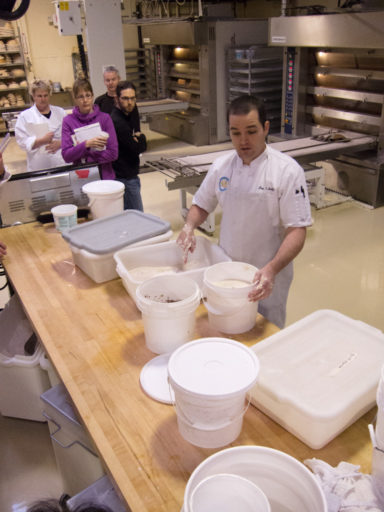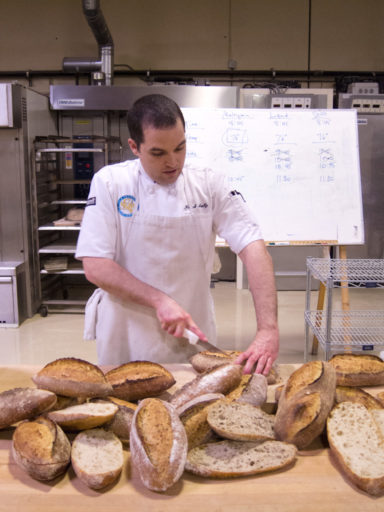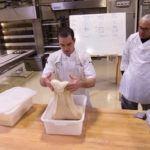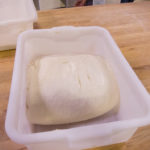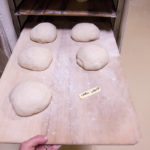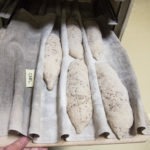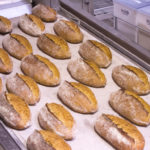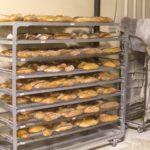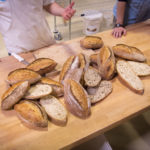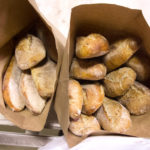Loaves 21 thru 23 – SFBI Class Day 1
San Francisco Baking Institute – Day 1
The San Francisco Baking Institute (www.sfbi.com) is a professional baking school. In addition to their full our professional courses, they offer week long and weekend long classes for those of us not quite ready to get a degree in baking. I signed up for the “Sourdough at Home” weekend class about a month ago and it’s finally time to take it.
Classes were on Saturday and Sunday from 8am to 4pm; there were 16 students and our instructor, Frank Sally. We were put into four groups of four, each assigned a table for the weekend to do our work at, and began right off getting our hands doughy. No time for class work or hellos, in order to finish our first three batches of bread by 4pm we needed to be mixing ingredients. We were making two different sourdoughs (one with a liquid starter, one with a stiff starter) and a whole wheat recipe. Each table’s batch had about 11 kilograms of flour, enough for 20 loaves of bread. Frank had already measured out the dry ingredients and the starter, so after a quick demo and a review of sanitation and safety rules, we were mixing huge tubs of ingredients by hand. If you’ve never been half-way up to your elbows in wet dough I’d say it’s worth the few dollars of ingredients to try it out – you’ll be transformed back to childhood mud pool days. Don’t forget to take of your watch and rings first!
After the mixing was done we learned about the process we’d be going through to make these loaves, and more specifics about the breads we were making. By 10am we had done two folds of the doughs (the first on the table and the second in the bins). In our first classroom session after introductions we learned about properties of the main ingredients in bread: the different types of flour and how the protein, starch and enzymes work to create gluten, carbon dioxide and acidity; the effect of water on hydration, chemical activity, dough strength and temperature; salt’s contribution to flavor, regulating chemical activity and fermentation tolerance; and a bit about yeast (most of that will come later).
At 11am we divided and pre-shaped the doughs into 500g boules and then got a lesson on how to shape batards (aka torpedoes). By 12:30 everything was shaped and the whole wheat loaves were headed into the industrial oven. The ovens are about eight feet on a side with eight separate compartments that are loaded via an interesting mobile conveyor belt. Each table would load up the belt with their loaves in a specific order so that we could identify our personal loaves later. They would be loaded into the oven and the next table would then do the same.
After lunch we measured all the dry ingredients for tomorrow’s breads and loaded our other sourdoughs into the ovens.
Most of the afternoon’s classroom time was spent talking about dough strength – elasticity vs. extensionability. This lead into talking about using mixers vs. hand mixing; there are pros and cons to each – tomorrow we’ll be using the mixers primarily because of the stiffness of the doughs we’ll be working with.
If you do the math, individually we each made 15 loaves of bread: five each of the two sourdoughs and the whole wheat. It was wonderful being able to practice shaping and scoring at that volume.
At the end of the day we had a tasting of a few of the loaves. I couldn’t really tell the difference between the liquid sourdough starter and the stiff sourdough starter – in theory the stiff starter should have be a bit more acidic. The taste of all three loaves was great – chewy interior with a flavorful crisp crust.
We also each went home with 15 loaves of bread. I’m only counting this as three for my “100 Loaves of Bread” tally.
- The Bread Lab at SFBI
- Frank introduces us to hand mixing on a large scale
- Sourdough starter mixed with extra water
- Showing how much extensionability has developed in only about 1/2 an hour
- Another 1/2 hour and the dough is even more structured
- Shaping lessons
- Our tub of dough – enough for 20 loaves at our table of four
- After a couple hour the dough has become very structured – it almost feels like a very soft taffy
- Flipping the dough onto the table to divide and shape
- Dividing the dough into 1/4s, then 500g loaves
- Pre-shaping into boules – stiff sourdough
- Shaping the stiff sourdough
- Pre-shaped liquid sourdough
- Liquid sourdough shaped and proofing
- Pre-shaped whole wheat
- Shaped whole wheat, ready to proof
- Stiff sourdough scored and queued up to bake
- Conveyor belt loading the oven
- Whole wheat loaves brought out of the oven via conveyor belt
- Cooling less than half the bread we made on Saturday
- Tasting time!
- Two types of sourdough and whole wheat loaves
- Fifteen loaves going home, and to friends








